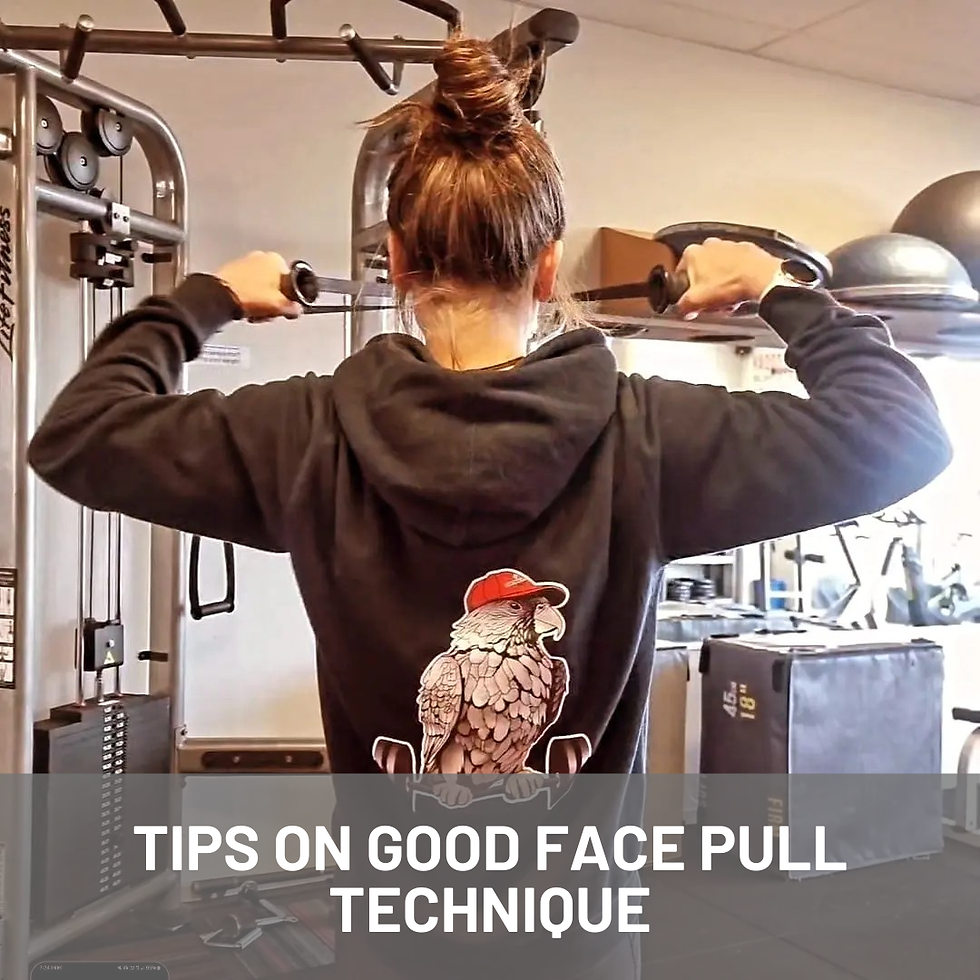Improving Your Face Pull Technique
- Shane Johnston
- Aug 25
- 4 min read
The face pull is a popular resistance exercise and when done correctly should target the
upper back, rear shoulders, and rotator cuff muscles. It is often used in warmup routines,
rehabilitation, and prehabilitation routines to improve posture, shoulder health.

What is a Face Pull?
A face pull involves pulling a rope attached to a cable machine or resistance band towards
your face, with your elbows flaring out and your hands at ear height but away from the ears.
The thumbs should point behind you and elbows at 90 degrees at the finish of the
movement. The exercise should emphasize shoulder external rotation and scapular
retraction if done well.
Set up:
Attach a resistance band or two ropes to a cable at face height.
Grasp the ropes or band with a thumb down grip.
Step back to create tension.
Pinch shoulder blades together (retract).
Pull the handles towards you making sure to flare the elbows out and roll the hands over externally rotating at the shoulder until thumbs face behind you.
Keeping elbows up slowly bring rms back to start position.

Reasons to do Face Pull Exercise
1. Improves Posture
Face pulls strengthen the rear deltoids, rhomboids, and teres muscles, which help
counteract rounded shoulders caused by prolonged slouching or forward head posture.
2. Enhances Shoulder Health
By targeting rotator cuff muscles and promoting scapular stability, face pulls can reduce the
risk of shoulder injuries and improve shoulder mobility.
3. Increases Upper Back Strength
This exercise effectively engages upper back muscles, contributing to overall upper-body
strength and muscular balance.
4. Rehabilitation and Injury Prevention
Face pulls are often incorporated into rehab programs for shoulder impingement and rotator
cuff injuries because they promote healthy shoulder mechanics.
5. Fantastic warm up and activation exercise.
Switching on the shoulder stabilisers and
bringing blood flow and warmth to the shoulder area is essential before doing upper body
pressing or pulling movements.
6. Adaptable
They can be performed with resistance bands, cables, or even body weight, making them
suitable for various fitness levels and settings.

Common mistakes when performing face pulls.
1. Incorrect form 95 % of people miss the whole point of this exercise when doing it.
Improper technique, such as placing hands thumb up to grip and internally rotating shoulders on the pull and not engaging the correct muscles. These all diminish effectiveness and increase injury risk, especially to the shoulders and neck.
2. Incorrect load for exercise.
95 % of people are conducting this exercise with too much weight against them. So we see
ineffective deviations in form. Such as staggering forward and not able to stabilise
themselves. Changing the angles of the pull to the collar bones which shifted load from
upper back and rear shoulders to rhomboids and upper traps which are bigger muscles.
3. Placing a single rope on the pull to do the exercise is a setup to fail.
In order to get the hands wide enough and high enough during correct face pull technique either use two ropes attached to the pulley or a resistance band attached to the pulley.
Alternatives to face pulls if no pulley available.
Wall Angels:
Wall angels are a simple exercise that targets shoulder mobility, posture, and the upper back muscles, making them a good alternative to face pulls for improving shoulder health.
Start Position:
Stand with your back flat against a wall, feet 10 cm away.
Keep your lower back, upper back, and head touching the wall.
Raise your arms to form a goalpost shape, with elbows bent at 90 degrees and the backs of your hands touching the wall.
Movement:
Slowly raise your arms overhead, sliding your hands up the wall while maintaining contact with the wall and keeping your back pressed against it. Lower your arms back to the starting position.
Repetitions:
Perform 10 slow, controlled reps focusing on maintaining contact with the wall. When done well these are real shoulder burners.
Why Wall Angels Are a Good Replacement:
They strengthen shoulder stabilizers and improve mobility.
They encourage proper posture and scapular positioning, similar to face pulls.
They do not require equipment, making them accessible.

Prone Ys on bench or floor.
Prone Ys are a resistance exercise performed lying face down (prone position) that target
the upper back, shoulder stabilizers, and rotator cuff muscles. They are excellent for
improving shoulder mobility, scapular stability, and posture—making them a good alternative to face pulls.
Starting Position:
Lie face down on a flat bench or the floor.
Extend your arms overhead in a "Y" shape, with thumbs pointing upward.
Keep your neck neutral, looking down or slightly ahead.
Movement:
Engage your upper back and shoulder muscles to lift your arms off the ground/bench.
Raise your arms slightly, squeezing your shoulder blades together. Hold for a second, then slowly lower your arms back down.
Repetitions:
Perform 10 controlled reps, focusing on proper form and scapular engagement.
Why Prone Ys Are a Good Replacement:
They strengthen the upper back and shoulder stabilizers, similar to face pulls.
They improve scapular control and shoulder mobility.
They are easy to perform without equipment (if on the floor).
They target the posterior shoulder muscles effectively.
As with any exercise the face pull is a highly beneficial exercise for warming up shoulders,
improving shoulder health and posture, and upper back strength. When performed with
proper form and appropriate loads, it can be a valuable addition to most training routines.
However, like any exercise, it requires attention to technique to avoid injury and maximize
benefits.
As always I'm here to help.
yours in good health
Shane.




Comments